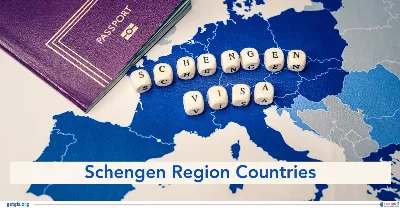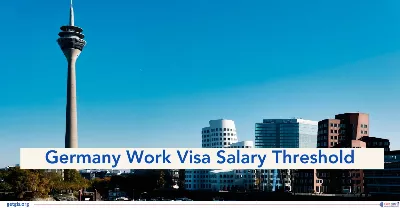Schengen Region Countries: Complete Guide to Visa Types, Requirements, and Travel Info (2025-26)
Updated On
-
Copy link
The Schengen Region countries are 29 European nations that have abolished internal borders for free and unrestricted travel. They follow a common visa policy, allowing movement with a single Schengen Visa.
Limited-time offer : Access a free 10-Day IELTS study plan curated for you

Table of Contents
- What are the Schengen Region Countries?
- What is the Schengen Agreement?
- List of the Schengen Region Countries
- Schengen Countries Entry Requirements
- What is a Schengen Visa?
- Where To Apply for a Schengen Visa?
- Documents Required for Schengen Visa
- How To Apply for a Schengen Visa from India?
- Immigrate To Schengen Region Countries WIth GetGIS!
The Schengen Region countries are part of a passport-free travel zone in Europe that includes 29 nations as of 2025. These countries have officially abolished border controls at their mutual borders, making it the world’s largest free travel area. The Schengen Agreement was signed in 1985 and implemented in 1995, creating a unified set of visa and entry rules.
The region includes popular destinations like Germany, France, Spain, Italy, and recently joined countries such as Romania and Bulgaria. With over 400 million residents and millions of travellers each year, the Schengen Area plays a crucial role in European mobility and economic integration. Let’s explore this region, its significance, and the visa details.
What are the Schengen Region Countries?
The Schengen Region is a group of European countries that have removed internal borders to allow free and unrestricted movement of people. It operates under the Schengen Agreement, promoting travel, trade, and cooperation. As of 2025, it includes 29 member countries.
- Internal flights and road travel between member countries require no border checks.
- All Schengen states follow shared visa and entry policies.
- The zone includes non-EU countries like Norway, Switzerland, Iceland, and Liechtenstein.
- Romania and Bulgaria officially joined the Schengen Area in 2024.
- Schengen Visa holders can stay up to 90 days within a 180-day period.
Also Read: Which are the Safest Countries in Europe to Visit in 2025
What is the Schengen Agreement?
The Schengen Agreement is a historic pact that laid the foundation for a border-free travel zone across much of Europe. Initiated by France and Germany in 1984, the idea was first discussed during a European Council meeting in Fontainebleau. A year later, on June 14, 1985, Belgium, France, Germany, Luxembourg, and the Netherlands signed the agreement to gradually eliminate border checks at their shared borders.
To turn the idea into action, these countries met again on June 19, 1990, to sign the Convention that laid out the detailed steps for implementation. Key components of the implementation included,
- Removing internal border checks between member countries
- Standardizing rules for issuing short-stay visas
- Creating the Schengen Information System (SIS) for security cooperation
- Coordinating immigration and police operations across borders
Quick Read: Schengen Tourist Visa from India in 2025
List of the Schengen Region Countries
The Schengen Region includes a total of 29 European countries that have removed internal borders to allow free and unrestricted movement. These countries follow a common visa policy and cooperate on security and immigration matters. Here is the updated list of Schengen region countries as of 2025.
- Austria
- Belgium
- Bulgaria
- Croatia
- Czechia
- Denmark
- Estonia
- Finland
- France
- Germany
- Greece
- Hungary
- Iceland
- Italy
- Latvia
- Liechtenstein
- Lithuania
- Luxembourg
- Malta
- Netherlands
- Norway
- Poland
- Portugal
- Romania
- Slovakia
- Slovenia
- Spain
- Sweden
- Switzerland
Explore: Top 10 Best Places to Visit in Switzerland in 2025
Schengen Countries Entry Requirements
The Schengen area implements unified regulations concerning visas and border controls at its external borders while eliminating checks within internal borders. Nevertheless, certain Schengen area nations might necessitate registration with local authorities shortly after your arrival, especially if you're lodging in private accommodations.
1. Visa-Free Travel to Schengen Area Countries
- Citizens of eligible countries can enjoy visa-free travel to Schengen area countries for up to 90 days within 180 days.
- Prior stays contribute towards the allotted 90 days if departing and re-entering within the same 180-day period.
2. Stays Exceeding 90 Days
- For stays exceeding 90 days within any 180 days, it is imperative to contact the high commission or embassy of the destination country before travel to obtain the requisite visa.
- Failure to procure the appropriate visa and overstaying the 90-day limit may result in fines or deportation.
3. Passport Entry Stamp
- Upon initial entry into the Schengen area, it's crucial to ensure your passport receives a stamp.
- The absence of an entry stamp from the first Schengen port of entry could lead to complications during encounters with local police or authorities within the Schengen area or during departure checks by immigration officials.
Check Out: How to Write a Cover Letter for a Schengen Visa
What is a Schengen Visa?
A Schengen Visa is a short-stay visa that allows travellers to enter and move freely within the Schengen Area for up to 90 days within a 180-day period. It is ideal for tourism, business, family visits, or short educational courses. The visa is accepted by all 29 Schengen Region countries.
- There are different types: Type A (airport transit), Type B (transit visa), Type C (short stay), and Type D (national Visa).
- You must apply at the embassy of the country that is your main destination.
- The application process includes submitting proof of accommodation, travel insurance, and financial means.
Types of Schengen Visas
Schengen visas are categorized based on the purpose and duration of your visit within the Schengen Area. Below is a breakdown of the main types of Schengen visas.
- Type A (Airport Transit Visa): This visa is for travellers who are changing flights in a Schengen airport and do not leave the international transit zone.
- Type B (Transit Visa): This short-term visa allows travel through Schengen countries by land or air for a maximum of five days.
- Type C (Short Stay Visa): Ideal for tourism, business, or family visits, this visa permits stays of up to 90 days within a 180-day period. The Type C visa can be obtained for,
- Single-Entry: One entry; exiting the zone ends the visa validity.
- Double-Entry: Allows two separate entries into the Schengen Area.
- Multiple-Entry: Unlimited entries during the visa’s validity, as long as the 90/180 rule is respected.
- Type D (National Visa): This long-term visa is issued by a specific country for study, work, or residency purposes beyond 90 days and is valid mainly in that country.
Where To Apply for a Schengen Visa?
The specific place where you must submit your application is determined by the rules in your home country and the country you plan to visit. You can submit your application at the following listed below.
- Embassy
- Consulate
- Visa center authorized by the embassy of your destination country
- An embassy or consulate of another Schengen country designated by the embassy of your destination country.
Suggested Reading: Schengen Visa Rejection
Documents Required for Schengen Visa
When applying for a Schengen Visa, it’s important to gather complete documents for a smooth processing. These documents help prove your identity, travel intent, financial stability, and ties to your home country. Below is a list of the key requirements.
- A valid passport that remains valid for at least three months beyond the visa’s expiration date.
- Complete the visa application form with personal details, travel purpose, and trip duration.
- Recent passport-sized photographs (35x45 mm) as per Schengen guidelines.
- Travel medical insurance covering all Schengen countries for the entire stay.
- Proof of accommodation, such as hotel bookings or an invitation letter from a host.
- Recent bank statements to show sufficient funds, based on the financial rules of the destination country.
- Proof of return intent, like a return ticket, marriage certificate, property documents, or a child’s birth certificate.
Explore: Understanding The Austria Tourist Visa Requirements
How To Apply for a Schengen Visa from India?
To ensure the success of your application process, it is essential to follow a few key steps. These steps are crucial in achieving a successful outcome.
Step 1 - Prepare the Required Documents: Before applying for a Schengen Visa, gather the necessary documents.
Step 2 - Visit the Embassy or Consulate: Once you've gathered all the required documents, visit the embassy or consulate of the Schengen country where you intend to apply for the visa. Additionally, you can even get in touch with GetGIS experts to get end-to-end assistance in applying for a Visa.
Step 3 - Submit Your Application: Present all the documents to the consulate staff. Ensure that all forms are filled out accurately and all required documents are included.
Step 4 - Provide Biometric Data: At the consulate, you'll need to provide your biometric data, which includes fingerprint scans and possibly a digital photograph. This data will be recorded and stored in the Schengen Visa Information System.
Step 5 - Pay the Visa Fee: Pay the required visa fee as instructed by the consulate. Most commonly, when applying from India, you will need to pay a visa fee of EUR 80.
Step 6 - Wait for Processing: After submitting your application and biometric data, you'll need to wait for the processing of your Schengen Visa application. The processing time may vary depending on the consulate and other factors, but a general time of 15 working days is taken for getting a response.
Step 7 - Collect Your Passport: Once your visa application is processed, collect your passport from the embassy or consulate. If your visa is approved, it will be stamped in your passport, allowing you entry into the Schengen Area for the specified duration and purpose.
Also Read: Guide to Reapplying for Schengen Visa After Rejection in 2025
Immigrate To Schengen Region Countries WIth GetGIS!
The Schengen countries offer great opportunities for international travel. At GetGIS, we provide valuable insights and guidance to help you immigrate safely to your dream destination, whether it's Schengen region countries or elsewhere. We also offer thorough assistance in obtaining permanent residence or citizenship in your desired destination.
Useful Links for You:
Limited-time offer : Access a free 10-Day IELTS study plan curated for you

Frequently Asked Questions
What is the cheapest Schengen country?
What are the Schengen area passport requirements?
Which Schengen country visa is best to apply for?
Which is the easiest Schengen country to get citizenship?
Which EU countries are not in Schengen?





